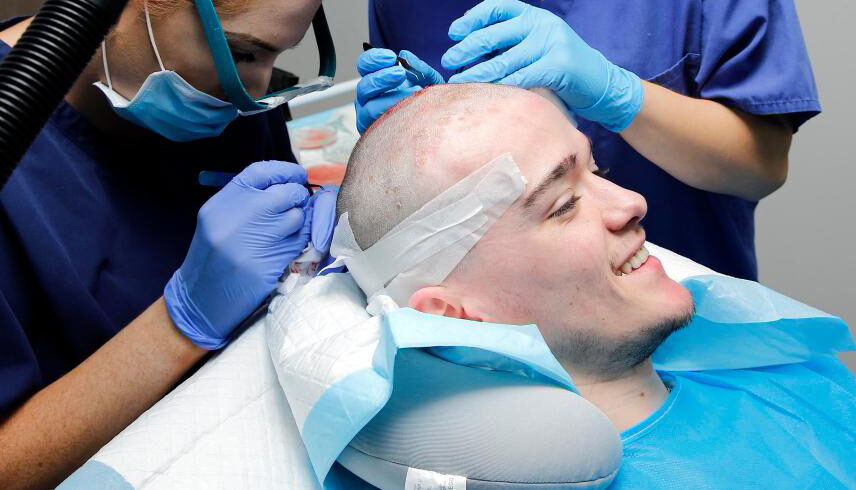Hair Loss in Women
Hair loss has often been seen as a male problem, with the majority of hair transplant patients being men. However, hair loss is still a very big problem among the female population. Did you know that in the USA, roughly 40% of all people who suffer from some form of hair loss are female, and in the United Kingdom, roughly 1 out of 5 women aged over 25 suffer with hair loss or thinning?
So What Can Cause Hair Loss in Women?
There are many things that could be contributing to your hair loss, including alopecia areata, telogen effluvium, polycystic ovary syndrome (PCOS), and even excessive hairstyling. Often, there are many influences on your hair loss, so it could be a combination of physical stress, hereditary hair loss and hormone imbalances.
What Is Alopecia Areata?
Alopecia Areata is caused by a problem with the immune system, where it mistakenly attacks hair follicles and the hair falls out, often in clumps or patches. Although this condition can happen to anyone, it is more common among younger people, and those with other autoimmune system conditions, such as hyperthyroidism or Down’s syndrome. Alopecia areata often leaves bald patches on the scalp, but hair usually starts to grow back in a few months, gradually getting darker and thicker over time. In some cases though, it can lead to more serious long term conditions, where the sufferer may have no hair on the scalp or even their whole body.
What is Telogen Effluvium?
Some sort of ‘shock’ to the system is thought to cause telogen effluvium. It is a type of non-scarring alopecia, but unlike alopecia areata, it is characterised by widespread shedding of hair rather than larger bald patches. When we talk about a shock to the system, it could be physical or emotional stressors which push more hair into the resting and shedding phase of the hair growth cycle than normal. Cases of telogen effluvium more commonly occur after serious emotional stress or physical stress such as childbirth, with many new mothers being concerned about their hair loss. Unless there is a hereditary history of alopecia, it is most likely that hair will stop shedding and begin to grow back in a matter of 6 months.
What Is Polycystic Ovary Syndrome?
Polycystic Ovary Syndrome (PCOS) is a condition which affects the ovaries, due to abnormal hormone levels or a hormone imbalance. Research has shown that this condition is often hereditary. Although PCOS can lead to excessive hair growth in some parts of the body, sufferers may notice hair loss or thinning on the scalp. One research study has shown that 67% of women who suffered some form of alopecia also suffered with PCOS, suggesting there is a direct link between the condition and hair loss. The hormone imbalance that is thought to cause PCOS means that there are higher than normal testosterone levels in the body. If you have already read our article on Male Pattern Baldness, you will know that higher levels of testosterone can have an impact on hair loss, as more dihydroxytestosterone (DHT) is being produced. This has been found to increase the rate of hair loss in people who are genetically predisposed to it. PCOS is often hereditary, and therefore it would make sense that the condition can affect your hair in some way.
How Can My Hairstyle Cause Hair Loss?
There are many hairstyles out there that could cause traction alopecia, a type of hair loss that can occur gradually by constant tight hairstyles, where too much stress is put on the scalp. Tight styles like ponytails, ballerina buns, or dreadlocks and weaves can all be culprits. The worst thing is that it often goes unnoticed until it is really obvious, because traction alopecia is caused by the gentle pulling at the roots over a longer period of time. You may not notice the strain on your hair when you are constantly tightening that ponytail or getting new hair extensions. It may only be when you opt for a less groomed hairstyle that you notice the thinning. The constant stress on your hair is adding more and more damage to the roots, until the hairs inevitably snap or fall out.
What Should I Do To Help The Situation?
The good news is that hair loss in women isn’t really that different to hair loss in men. There may be different causes, but they can still be treated in some way. In some cases it is simply a matter of looking after yourself a bit more and not running yourself into the ground with stress. Take some time away from the hair extensions and research your hair loss concerns in great depth. This way you will be able to find out what the best course of action is for yourself.





